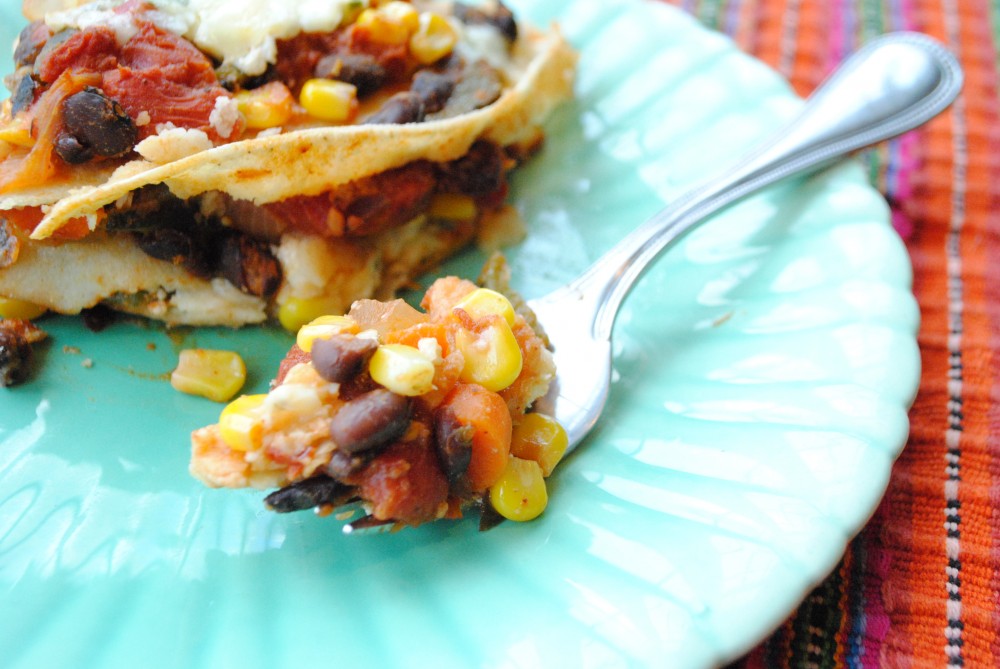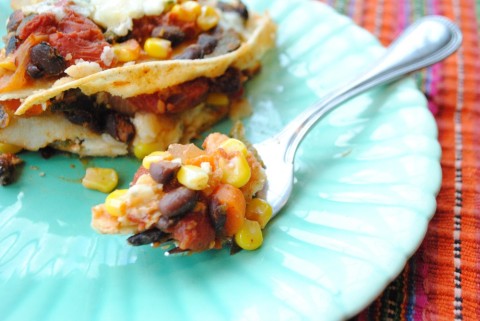
The following is a guest post by my fiance, Anthony Damelio…
As an Italian-American, lasagna and its myriad baked pasta relatives have always been close to my heart and stomach. I adore the freedom of being able to combine whatever seasonable vegetables I might have on hand with any type of short pasta, using a variety of sauces and cheese combinations. It’s also helpful to be able to assemble them ahead of time, slide them in the oven, and walk away to prepare something else. Plus, they’re great for a group.
When I first tasted this Aztec Pie, a creation of my BorderLinks co-worker Nick, I was amazed. It screamed baked pasta to me, but everything about it tasted of Mexico: what an incredible combination! Mexican lasagna! It was the first of many recipes I have continued to make from my co-workers’ repertoire. Our trip participants loved it at the time, and it was one of the many ways we communicated the issues of migration and food justice to them through their taste buds.
BorderLinks is a bi-national, educational non-profit dedicated to helping folks understand the root causes of migration issues. Based in Tucson, AZ, for more than 20 years, it has been receiving groups from churches, high schools, colleges, seminaries, and more, to take educational delegations on both sides of the U.S.-Mexico border. I worked as a trip leader at BorderLinks for a year before coming to Yale Divinity School, and the organization and area formed me in ways I could never have predicted.
Part of BorderLinks’ current work is a sustainable food program. Years ago, they recognized the interconnectedness of food issues and migration concerns—everything from migrant workers who have been picking U.S. produce for decades to the ways in which free trade agreements and subsidies disable local Mexican farmers and small U.S. producers alike. It pushed me to address these issues in my own life, with some of the most important choices I make on a daily basis—what goes into my stomach.
These changes in my consumption did not happen all at once, either; I remember pushing back hard against sustainable meat consumption in particular. I could buy into local produce, but my habit was still to buy whatever I needed to produce the dish I wanted. But, little by little, my food habits were transformed. This is always a process, and we can always do better, advocate louder, encourage each other more.
One of the best ways for me to transform my habits was to eat the wonderful meals produced by my co-workers, Nick and Susanna, who had a repertoire of vegetarian dishes to feed ravenous—and often skeptical—groups (and even some skeptical trip leaders like me). I am proud to share one of their recipes and hope to offer more of them in the future.
If you’re interested in the work of BorderLinks or purchasing their wonderful—and cheap!—cookbook, take a look here and around the rest of their site.
* * * * * * * * * * * * * * * * * * * * * * * * * * * * * * * * * * * * * * * * * * * *
Aztec Pie
Poblanos are very mild, dark green chile peppers. Roasting them before layering them into this dish adds the perfect amount of smokiness and heat. If you’d prefer to make this dish milder, simply substitute bell peppers and roast them in the same fashion.
Epazote is a Mexican herb with a very unique flavor—just a little transforms the flavor of the sauce. It is available fresh or dried at most Latin American grocery stores and you can also order it online. If you can’t get it, simply increase the oregano from 1/2 to 1 teaspoon and add 1/4 cup chopped fresh cilantro to the yogurt-cheese mixture. If you’re lucky enough to find it fresh, use 1 sprig stemmed & finely chopped.
This recipe calls for Ancho chile power because it is mild, slightly sweet, and fruity, and adds wonderful flavor to this dish, but if you can’t find it, regular chile powder works fine.
- 6 poblano chiles
- 1 tablespoon olive oil
- 1 medium onion, diced
- 1 large carrot, diced
- 4 cloves garlic, minced
- 1 tablespoon dried epazote, crumbled (see note above)
- 2 teaspoons ancho chili powder (see note above)
- 1 teaspoon cumin
- ½ teaspoon oregano, preferably Mexican oregano
- 2 28-oz cans whole plum tomatoes
- 2 ears of corn, cut off cob (or two cups of frozen corn)
- 2 cups drained cooked black beans
- ½ cup sour cream
- 1 cup plain yogurt
- A generous pound of grated sharp cheddar or pepper jack cheese (about 5 cups)
- 24 small corn tortillas
- Salt and pepper to taste
- Adjust oven rack to highest position and turn broiler on high. Place peppers on a rimmed baking sheet and broil, turning once, until browned and blistered on both sides, 10 to 12 minutes total. Remove peppers and place in a plastic bag to steam; heat oven to 350 degrees. Once peppers are cool to the touch, skin, stem, seed, and cut them into thin, short strips.
- Meanwhile, heat oil in a large soup kettle over medium-high heat. Add onions and carrots; sauté until soft, 5 to 7 minutes. Stir in garlic, epazote, chili powder, cumin, and oregano, and cook until fragrant, about a minute. Add tomatoes and their juices, crushing them with your hands to break them up. Bring to sauce to a simmer, reduce heat to medium-low and continue to simmer, partially covered and stirring occasionally, to blend flavors 15 to 20 minutes. Stir in black beans, corn, and roasted peppers. Adjust seasonings, including salt and pepper to taste and additional spices as desired. Simmer for a few more minutes to allow the beans and corn to heat through.
- Meanwhile, mix sour cream, yogurt, and 4 ½ cups of the cheese in a medium bowl.
- Coat a 9x13-inch baking dish (preferably glass or ceramic) with oil or nonstick cooking spray. Spread ½ cup of sauce on the bottom of the pan. Make 4 layers in the following order: 6 corn tortillas, overlapping as necessary, 2 cups sauce, 1 cup cheese mixture. Sprinkle with remaining ½ cup of cheese.
- Bake, uncovered, until hot and bubbly, 25 to 30 minutes, being careful not to over-bake, as tortillas will begin to fall apart. Let rest a few minutes. Cut and serve.

This was such a great casserole, Tony. Thank you for introducing it to me. The ingredients are so basic but the dish presents special. Plus it has such wide appeal… and meatless too! I didn’t have the epazote so I did the up the oregano and add the cilantro trick and it worked great. Definitely adding this to my regular repertoire.
Sounds wonderful, will try and let you know….
This filling would be lovely stuffed into pepper halfs, topped with a bit of cheese, and baked until the peppers are done. 🙂